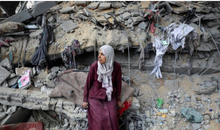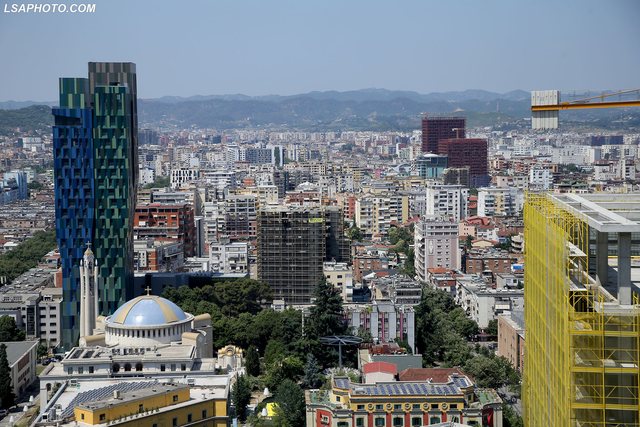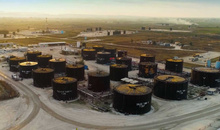
 Flash News
Flash News
Arrests of "Bankers Petrolium", Prosecution provides details: Exported and sold 532 billion lek of oil, caused millions of euros in damage to the state
Ndahet nga jeta tragjikisht në moshën 28-vjeçare ylli i Liverpool, Diogo Jota
Posta e mëngjesit/ Me 2 rreshta: Çfarë pati rëndësi dje në Shqipëri
Ceno Klosi with over 800 stolen votes, Balluku finds the reason is the tiredness of the counters
"Fast & Furious" in the former Block, police chase an Audi Q8, 4 cars collide
Report: Temperatures within Tirana vary by 6 degrees from neighborhood to neighborhood, from concrete

High temperatures and heat waves that have become longer and more intense can be experienced with marked differences within the same city.
This highlights the importance of urban planning in cities by focusing on elements that create microclimates.
The latest World Bank report, titled "Uninhabitable: How Cities in Europe and Central Asia Can Survive and Thrive in a Hotter Future," brings to attention a campaign undertaken in 2023 by a team of 10 volunteers from New York University in Tirana that yielded interesting data.
“The role of land cover and urban form in determining thermal conditions is highlighted by a measurement campaign conducted in Tirana, Albania, during the summer of 2023. A team of 10 volunteers recruited from New York University Tirana placed temperature sensors on car windows and followed planned routes through the city. Tens of thousands of near-ground temperature measurements were taken during three separate vehicle movements (carried out at 6–7 a.m., 3–4 p.m., and 7–8 p.m.).
By linking heat measurements to land cover characteristics through a machine learning model, a high-resolution temperature map was created for the entire city. It showed strong spatial variations in heat exposure in Tirana during the campaign, with a difference of 6.4°C between the hottest and coolest neighborhoods.
Areas with a higher percentage of solid, impervious surfaces, such as roads, parking lots, and buildings, showed higher temperatures, while areas with more trees and grass were consistently cooler. The hottest areas coincided, at least in part, with lower-income communities: neighborhoods composed of single-story homes were significantly cooler, while areas with average buildings and few trees were hotter,” the WB report says, referring to this study.
The report focuses on the Orbital Forest project, which aimed to plant 2 million trees in a circle around the capital, but the latest data reported in the document is for up to 300 thousand trees planted by 2019.
The report highlights that rising temperatures should be taken seriously as the impacts are becoming increasingly severe across sectors, including energy. Specifically, the report says that countries need to strengthen the resilience of energy systems to extreme heat.
“As summer temperatures rise across Europe and Central Asia, power systems are facing an increasing strain. Heat waves increase the demand for electricity for air conditioning, refrigeration and water pumping while simultaneously reducing the performance of energy infrastructure.
In countries like Turkey and across the Western Balkans, the peak in electricity demand that used to occur in winter is now shifting to summer. This shift was dramatically illustrated in June 2024, when an early heat wave caused widespread power outages in Montenegro, Croatia, Bosnia and Albania, driven by rising demand and declining performance of energy assets.
"Extreme heat damages energy infrastructure in several ways. High air temperatures reduce the efficiency and capacity of transmission lines, which can become dangerously sagged or transport less energy," the document highlights./ Monitor
Latest news


Diddy's trial ends, producer denied bail
2025-07-03 15:02:41

Agricultural production costs are rising rapidly, 4.8% in 2024
2025-07-03 14:55:13
Warning signs of poor blood circulation
2025-07-03 14:49:47
Croatia recommends its citizens not to travel to Serbia
2025-07-03 14:31:19
Berisha: Albania is the blackest stain in Europe for the export of emigrants
2025-07-03 14:20:19


'Ministry of Smoke': Activists Blame Government for Wasteland Fires
2025-07-03 13:59:09

AFF message of condolences for the tragic loss of Diogo Jota and his brother
2025-07-03 13:41:36
Five healthy foods you should add to your diet
2025-07-03 13:30:19






A unique summer season, full of rhythm and rewards for Credins bank customers!
2025-07-03 12:12:20

Fire situation in the country, 29 fires reported in 24 hours
2025-07-03 12:00:04
The constitution of the Kosovo Assembly fails for the 41st time
2025-07-03 11:59:57
The gendering of politics
2025-07-03 11:48:36

The price we pay after the "elections"
2025-07-03 11:25:39

Xhafa: The fire at the Elbasan landfill was deliberately lit to destroy evidence
2025-07-03 11:08:43

The 3 zodiac signs that will have financial growth during July
2025-07-03 10:48:01
Democratic MP talks about the incinerator, Spiropali turns off her microphone
2025-07-03 10:39:24

Ndahet nga jeta tragjikisht në moshën 28-vjeçare ylli i Liverpool, Diogo Jota
2025-07-03 10:21:03
Cocaine trafficking network in Greece, including Albanians, uncovered
2025-07-03 10:10:12



Korreshi: Election manipulation began long before the voting date
2025-07-03 09:39:13
Arrest of Greek customs officer 'paralyzes' vehicle traffic at Qafë Botë
2025-07-03 09:28:41
After Tirana and Fier, the boxes are opened in Durrës today
2025-07-03 09:21:10
Enea Mihaj transfers to the USA, will play as an opponent of Messi and Uzun
2025-07-03 09:10:04

Foreign exchange, the rate at which foreign currencies are sold and bought
2025-07-03 08:53:50
Index, Albania has the worst quality of life in Europe
2025-07-03 08:48:10


Horoscope, what do the stars have in store for you today?
2025-07-03 08:17:05
Clear weather and high temperatures, here's the forecast for this Thursday
2025-07-03 08:00:37
Posta e mëngjesit/ Me 2 rreshta: Çfarë pati rëndësi dje në Shqipëri
2025-07-03 07:46:48




Lufta në Gaza/ Pse Netanyahu do vetëm një armëpushim 60-ditor, jo të përhershëm?
2025-07-02 21:56:08
US suspends some military aid to Ukraine
2025-07-02 21:40:55



Methadone shortage, users return to heroin: We steal to buy it
2025-07-02 20:57:35
Government enters oil market, Rama: New price for consumers
2025-07-02 20:43:30
WHO calls for 50% price hike for tobacco, alcohol and sugary drinks
2025-07-02 20:41:53







Israel agrees to 60-day ceasefire in Gaza, but many unanswered questions remain
2025-07-02 18:35:27
The weather in Germany is going "crazy", temperatures reach 40°C
2025-07-02 18:22:21

"Fast & Furious" in the former Block, police chase an Audi Q8, 4 cars collide
2025-07-02 17:59:25
"Birth on a tourist visa? US Embassy warns Albanians: This is prohibited!"
2025-07-02 17:48:16


BIRN: Fier recount reveals vote trafficking within open political party lists
2025-07-02 16:57:19

CEO and former director of 'Bankers Petroleum' arrested in Fier
2025-07-02 16:40:42
Car hits two tourists on a motorcycle in Fushe Arrëz, one of them dies
2025-07-02 16:33:23



Fire at the Elbasan Incinerator Landfill, Prosecution Launches Investigations
2025-07-02 15:34:54
What you need to know if you travel to a country with active volcanoes
2025-07-02 15:33:03



EU proposes 90% reduction in greenhouse gases by 2040
2025-07-02 14:50:23
Europe is burning from the heat / Italy and France are on maximum alert
2025-07-02 14:36:52

Moscow's contradictory statements: Is the friendship with Vučić breaking down?
2025-07-02 14:21:05
'I lost my battle': Sea warming is killing fishing in Albania
2025-07-02 14:08:35
Sekretet kimike që ndihmojnë në mbajtjen e mjaltit të freskët për kaq gjatë
2025-07-02 14:01:26

Denmark makes historic decision to make military service mandatory for women
2025-07-02 13:44:33
The appeal of the GJKKO leaves former judge Pajtime Fetahu in prison
2025-07-02 13:30:20
Productivity losses could reduce GDP by 1.3% as a result of extreme heat
2025-07-02 13:21:04
He abused his minor daughter, Zamir Meta is left in prison
2025-07-02 13:04:04

